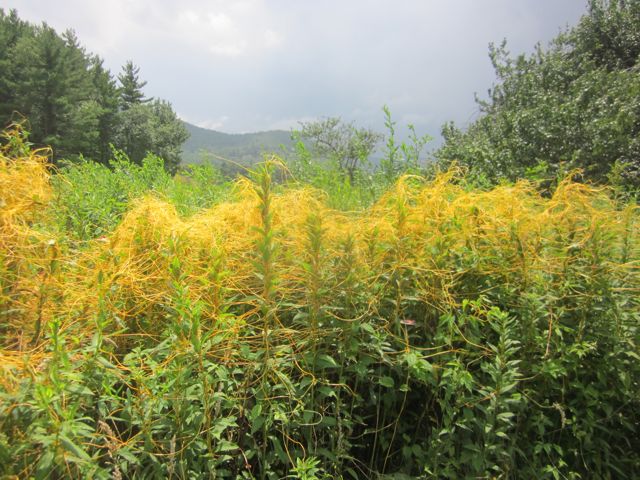
The below monologue is not about an edible plant, though it does resemble spaghetti, it isn’t even about a plant that I like. I have a deep aversion to this plant and since I have been forced to spend SOOOOO much time with it… I decided to blog about it. It is called Japanese Dodder Vine (Cuscuta spp) a particularly striking member of the Convolvulaceae family. It’s common names are: the vampire plant, lovevine, strangleweed, hellbind, goldthread, witches shoelaces and devil’s guts.

For those living locally I have spotted it on Big Hill road along the New River, on top of Junaluska mountain, under the power line along 194 near the DOT, between the golf course and the Methodist church on Deerfield road in Boone AND in my backyard. How it got to my back yard is a mystery but one thing I’ve learned upon dealing with it for the past 3 Summers, it is here to stay.
Here is the story…
June, 2008 my father had an accident where his spine was broken and as he languished in the hospital for 3 months I spent as much time with him as possible. Being Summer, my garden was left to fend for itself. One particular 3 week stretch I returned home from being with my Dad to an unforgettable sight. Orange spaghetti was matted in glistening globs all over my back yard plants. A usual amazon of lively poke weed, yellowdock, goldenrod, evening primrose, ironweed, joe pye weed, lambs quarter, jewelweed, burdock, amaranth…. the plants were mere black skeletons. I starred horrified. I had never seen anything like it. It didn’t take long searching the web to ascertain that the culprit was a noxious parasitical vine called, Japanese Dodder Vine. The more I learned about it the more indignant I felt and the more determined I became to rid my land of this orange scourge.
But it has never gone away. It comes back every year. It is a daily duty to search for it’s stranglehold and eradicate it. The seeds lay dormant in the soil for up to SIXTY YEARS. And since it had flowered and seeded while I was away caring for my father it will be a constant battle to fight for as long as I live here.
“If you are a horror movie producer looking for inspiration, this could be your plant! It has it all: long orange tentacles to grasp and entangle its victims, suckers to drain their life juices, and a devastating lifestyle to match that of any hostile alien symbiont.” (quote from The Garden Geeks)
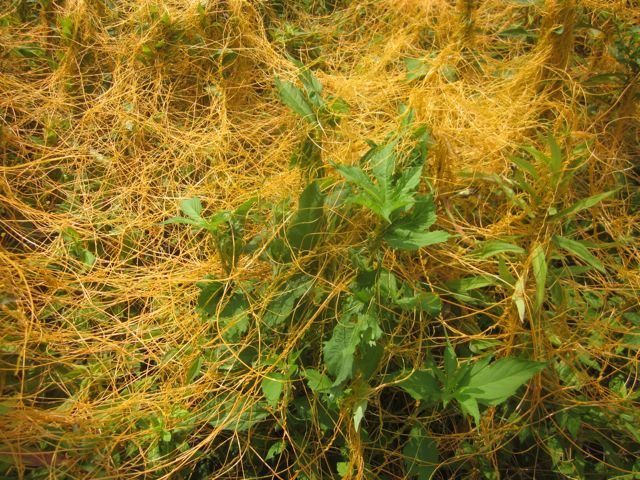
Farmers have placed the dodder – aka “Strangleweed,” “Devil Guts,” and “Witches Shoelaces” – on a ten most-wanted list of weeds. Swarthmore College biology professor Colin Purrington says the vine starts out as just a tiny tendril with no roots or leaves. It then has about a week to find a host plant it can wrap itself around. “It’s probably one of the creepiest plants I know,” says Purrington. “It’s a horrible existence for the host plant. If plants could scream, they’d have the loudest screams when they had Dodder attached.”
Even though I absolutely hate this parasitical colorful plant, it has taught me a few Spiritual lessons as I have been up close and personal with it for many many dedicated hours. It seems to me that the Dodder Vine and Sin are a suitable analogy, paralleling each other in tactics and it’s destructive effects.
I have used the time seemingly wasted ripping up host plants to the Dodder vine in praying for my sons that they would live untangled lives free from sin and it’s destruction.
What the Bible says about sin, it’s agenda, it’s mannerisms and it’s effects
Genesis 4:7 “Sin is crouching at the door, and it’s desire is for you, but you must master it.”
Hebrews 3:13 “But encourage one another day after day, as long as it is called “Today”, so that none of you will be hardened by the deceitfulness of sin.”
Psalms 38:3 “There is no health in my bones because of my sin.”
Romans 6:23 “The wages of sin is death”
Hebrews 12:1 “Let us also lay aside every encumbrance and the sin which so easily entangles us…”
Hebrews 12:15 “See to it that no root of bitterness spring up causing trouble, and by it many be defiled.”
John 8:34 “Jesus said, “Everyone who commits sin is a slave to sin”
1 Timothy 5:22 “Keep yourselves free from sin”
2 Corinthians 2:11 “That no advantage would be taken of us by Satan, for we are not ignorant of his schemes.”
John 10:10 says “The thief comes ONLY to steal, kill and destroy. I (Jesus) came that you might have life and have it to the full”.
It all reminds me of the story of Pinocchio. The wooden puppet who had become a ‘real’ boy. He had left the safety of his father, Gepetto’s, clock shoppe to venture with the wrong crowd to ‘Pleasure Island’. They were all having a swell time till Pinocchio realized that all his newfound friends were sprouting donkey ears and tails and turning into asses. Sin will make an ass out of us! Yet if sin were not alluring none of us would allow it to fasten it’s grip on us. Unlike Pinocchio’s escape, unhappy plants that fall under the Dodder’s spell do not fare so well. In fact, once the vine coils around the healthy stems the vampire-like Dodder then sinks its fangs into its victim and starts drinking. If left alone the host plants will be sucked of all their life and color leaving a mass of black death.
Lessons I have learned from the Dodder vine and it’s analogy to sin:
1. Like Dodder, sin is often colorful, eye catching and alluring… yet as you will see with the eye catching and morbidly fascinating Dodder vine…. all that glitters is not gold! Sin does not bring life, it sucks life. Dodder is bright orange, it has no chlorophyll of it’s own. Because of this problem, Dodder vines must function as parasites to obtain nourishment from other plants.
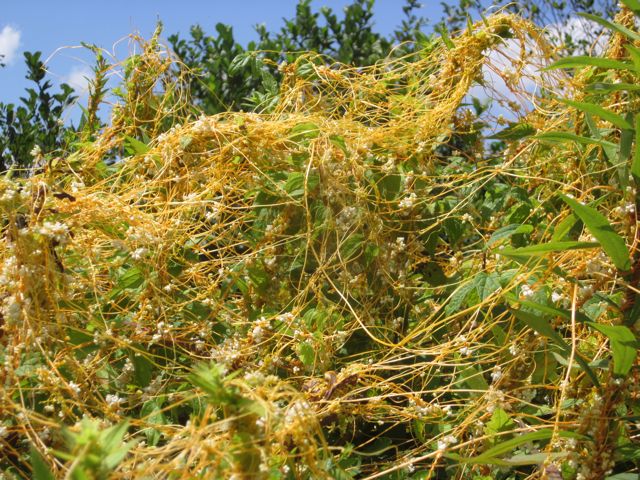
2. Sin often appears deceptively harmless. The Dodder vine starts out as just a tiny tendril with no roots or leaves. Once the seed has germinated it has only a few days to find a host plant it can wrap itself around. If it does not it will die. An established vine has many long fragile and willowy orange tentacles which appear totally harmless as they tickle would be hosts. “I will not hurt you” it seems to say. Look how friendly I am… These flexible soft tendrils can go in many directions at once sniffing a suitable victim.
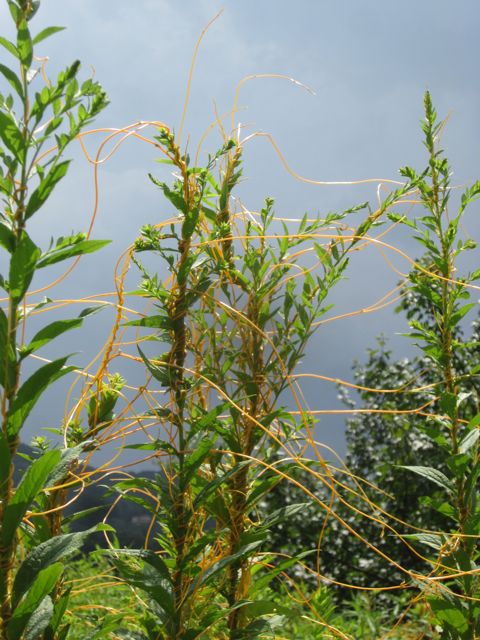
3. Yet when sin gets a stranglehold it brings death. Romans 6:23 “The wages of sin is death”. Once the orange tendrils find a willing host it coils around with a vice grip and does not stop till it has encircled the host always counterclockwise in it’s hungry navigation, sometimes doubling back over it’s original tracks and always reaching out to other plants in it’s pursuit of MORE. Inserting specialized roots called haustoria (like vampire fangs) that actually penetrate and invade the tissues of the host plant, water, minerals, and carbohydrates are obtained directly from the host. The root portion of the Dodder dies and the plant separates from the soil, now being entirely dependent on the host plant to sustain it and support it’s voracious habit of spreading up to 6 inches a day in all directions.

4. If sin is not dealt with decisively it brings forth a multiplicity of more devastation and long term consequences. The mother plant has the potential of producing 16,000 seeds per season. NEVER let Dodder vine become established. If left unchallenged the orange spaghetti monsters pile on top of each other in a dense mat where they flower, seed and blow their poisonous wares in all directions while turning all the host vegetation below black and lifeless. Seeds spread in a circumference of 10 feet. The seeds can remain viable and dormant in soil for up to 60 years. Not only is the Dodder vine parasitic but it is known to spread various plant diseases.

5. It takes daily due diligence to uproot any known sin to keep it from infecting further and spreading it’s effects to others. Likewise, I have to be on Dodder Vine patrol almost daily to keep it under control. Last week I had let 8 days or so go by without investigating and when I finally did it had spread it’s orange nastiness to the size of a mini van. The best bet is to hand pull the dodder and its infested host, roots and all. It is especially important that you destroy the dodder vine before it sets seeds. If you find it on plants around your home it would be prudent to destroy it immediately. It is a weed in no danger of extinction that has the potential to be a gardener’s nightmare.
6. Be thorough in your treatment of sin and in eradicating Dodder. Even a tiny piece of Dodder left will continue to wreak havoc. Fragments carried by wind, water, people, or birds also start new tangles. After dying back in winter, it grows back strongly in spring. To kill the parasite, the host plant usually has to be ripped up by the roots and killed. All fragments of vine and host plant must be buried in landfill (not composted). I put the whole mess in large plastic bags and take them to the landfill. Burning is not effective and leaving them on a leaf pile will only spread it’s effusiveness to more areas of your land.
7. Replace sinful habits with life giving habits. ‘Empty place is still a place’, the old saying goes. There are some plants that actually are immune or resistant to Dodder vine infestation, such as: cereals, corn, soybeans, velvetbeans or cowpeas. Planting these in an infested and eradicated area may assist in control. Replace sin with life giving and healthy choices!
Surprising Usages
I found it surprising as I did my research that Dodder has several medicinal gifts. I collected a bucketful of Dodder in full flower and am brewing a tincture to see how it works medicinally. I used gloves to collect from the most abundant patch and was VERY careful to keep the bucket covered so as not to inadvertently spread the seeds. It is just an experiment for me and I’ll let you know what I learn in the process.
“Various dodder species have been used to treat a great variety of different ailments. Some are thought to take on and enhance the medicinal properties of the plants they parasitize. The dodder that grows on thyme (Cuscuta epithymum) has been a favorite in European folk medicine.” Well maybe BUT why not just use THYME?
One of my favorite herbalist of all time Jim Macdonald told me this. “In Chinese medicine Dodder seed is a valued medicinal in Chinese medicine – said to help sperm production and motility. Michael Moore wrote about the use of dodder (the herb) for lymphatic inflammation and congestion, and swollen spleen. I imagine it might have a similar effect on swollen lymph glands.”
Hmmm. Infertility is a huge issue in our society, thanks to vaccines, fluoridated water and now in many foods, genetically modified foods (lots of culprits) so I did raise my eyebrow with the thought that Dodder may boost sperm production and motility.
So there may just be a silver lining to this orange cloud.
Another possible analogy to the Dodder vine and it’s cunning might be our parasitic government (without any redemptive qualities)
….just sayin…
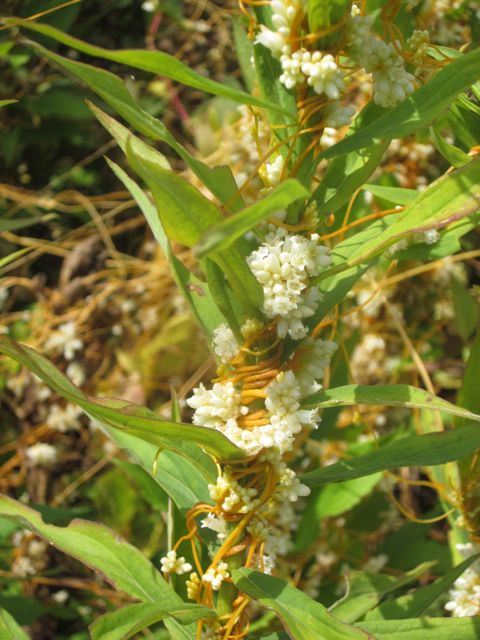
September 3rd Dodder Vine update
One is never quite out of the quicksand once this parasitical orange silly string decides to take up residence…. My day was planned, full of pressing duties and personal agendas… All of that was turned on its ear when Skipper and I took a short walk through our backyard just to see what Nature’s wave was bringing with the cooler weather. Keenly scanning the greenscape…. and then…….
ORANGE and more ORANGE and more…. Plans averted…. the new priority was to get all of this sneaky vine. I set to ripping up the unhappy host plants from their roots. Half an hour later all that I could find was stuffed into a black trash bag and tightly sealed for a trip to the dump. Really, it doesn’t matter that I’m tired of this plant or bored with it’s antics, it becomes top priority to eradicate it before it snakes off into more of my green wild jungle ensnaring unsuspecting plants. Left to itself it would not stop. So I have to be vigilant and daily in my commitment to rip up Dodder from my yard. Every day, day after day…. Reminded me again of the admonition in Hebrews 3:13 “But encourage one another day after day, as long as it is called “Today”, so that none of you will be hardened by the deceitfulness of sin and fall away from the Living God.”
If I have to take a plant’s aggressive destruction seriously how much more do I need to uproot sins deceptive grasp in my life? Just can’t let it go and set up a stranglehold! So take a daily walk around the perimeters of your heart and mind and be ruthless with anything that might be fastening it’s grip on you.
Psalms 101:2-4 “I will walk within my house in the integrity of my heart. I will set no worthless thing before my eyes; I hate the work of those who fall away; it shall not fasten its grip on me. A perverse heart shall depart from me; I will know no evil.”
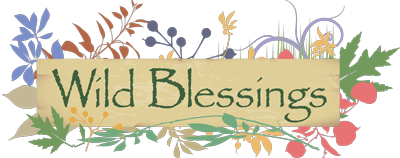


Great article! Have not seen any around here…very disturbing plant…end time pestilence?
If infertility is going to be an increasing problem then Dodder may be a blessing in disguise. I am morbidly fascinated with this plant. Why is it forever gifted to me? There must be a reason.
Thanks for the clarification of the weird “spaghetti weed”. Your comparative points on sin and
Dodder’s were excellent and perhaps now we know why it came to your yard. :> Way to make
lemonade from lemons! Now, I want to know if you’ve had the pleasure of meeting crown vetch?
Hi Jane! Happy to know you are reading my wild ramblings! Yes, I have met Crown Vetch, is there a lurid story with this ‘royal’ plant?
Great article! I love your comparison between the dodder and sin….and with our out-of-control government. Hmmm.
Thankfully, I haven’t seen any dodder in my yard, but we’re having a similar problem with another vine that looks like Morning Glory (maybe it is Morning Glory?). It’s also wrapping itself around everything, very much like the dodder in your photo. Any ideas for getting rid of it? It’s everywhere in our yard, and we can’t pull it out fast enough to keep up with it??
Thanks!
-Catherine
I think Dodder and Morning Glory are distant relatives. I’ll look that up. No Catherine, I have no helpful hints on getting rid of Morning Glory. Once you use poison to control weeds it takes 2 years of non toxic use to be able to eat the weeds from that area, so I don’t recommend chemicals.
Pulling it is the only thing that comes to mind, especially before it sets seed. Get it early before it is interwoven with other plants and use the time to pray for freedom!
Morning Glories are NOT edible unfortunately.
Holly, I loved your article. Just a comment about Morning Glory aka “Bindweed.” I read where if you consistently pull up the leaves, so the root is starved, and don’t disturb the root, after a couple of years it will die off. I am currently working to erradicate it from my flower beds. It seems to be less invasive the more I keep it pulled up.
Just came in from Dodder vine patrol. I had overdosed on thinking about this plant by writing this blog and didn’t bother to check for the past few days. At first glance it appeared like it was tired of trying to outwit me and had retired. Upon closer inspection I noticed that it was still there only had shifted it’s color palette to a innocuous paler shade (orangy greenish). The sneak!
I also noticed that where the boys had ‘helped’ rip up the host plants a few weeks back they had not ripped all of them up by the roots and those half plants were once more entwined and sending forth tentacles to spread the love.
One last observation is that though blackberries grow prolifically in the area where Dodder has set up shop, the vine avoids Rubus fruticosus entirely. I’ll have to think on the implications of that one….
Well I’ll be…. my friend, Analita, just sent me this link to the benefits of Dodder vine (seeds in particular). God never wastes anything, He can even use this mysterious plant for our benefit.
Read on here: http://www.wisegeek.com/what-is-dodder-seed.htm
Wow!….scary!…..I thought bind weed was horrible …..so hard to control……than
I came across the site by Timothy Lee Scott, the author of invasive plant Medicine…
read about the medicinal properties of bind weed and was surprised! It was helpful
For digestive problems…..which I have been plagued with all my life…..except when
I went totally raw…no meat, no processed food. I am able to stay in the saddle for
awhile……than I fall off…..I am still getting back in the saddle, so I suppose there is
still hope. I absolutely love your site,and all your personal thoughts not just the facts!!
I wish I lived near so I could participate in your classes!
Take care, I hope your Father is o.k. I am trying to help out my Dad , he will be 96
this Nov. He has always been interested in plants as well as planets- retired Astronomer
I help him with his garden….and point out the wild edibles.
Namaste
I’m learning that invasives are given for a purpose. Lots to discover about them, but I’d still like to curb their rambunctiousness to protect the other plants from being overrun.
I grew up in Kansas and am very familiar with the danger and beauty and immediate action required when one sees this plant. I had already seen it as a metaphor before I read your article! As I read your blog and you likened it to sin, that is exactly what I was thinking when I started looking for the name of this orange stringy weed I so clearly remember – and, seems like we burned it in KS . . . nothing like some Holy Ghost cleansing fire, right?
But, where I am really going was . . the emasculation that happens when men, young men, make wrong choices either out of fear, powerlessness, weakness, victim mentality – whatever sets the scene, and that moment hits where they wimp out and such is the beginning of the growth of the snare, producting women hatred (strong women without intending to stir weak men to feel worse), self-hate, anger, a torrential ‘wrestling in the spirit’, because there’s happened a conflict in their beliefs. I watched this happen as my son wrestled (and he went farther down and farther down and farther down) after his ex gf informed us all she was pregnant and he told her he couldn’t raise a child and left her to decide on her own . . . I saw feminist behavior surface, hate, hate, hate surface, a restlessness that wouldn’t relent, and an impending darkness of what felt like doom. Finally the pieces all came together for me to know what I was seeing and one little three minute conversation and, I’m sure, some serious talking to God afterwards, and my son told me the next day, ‘mom, I feel free’! I think there needs some serious attention to equipping our young men to understand what strong men are (courageous only thru Christ) . . . in light of all the shootings have been done by young men.
Daleen,
Thanks for sharing your heart. Amazing what plants will evoke as we meditate on His creation. So many lessons showing us the ways of God and what happens when we choose our own path apart from His unfathomable love.
God bless you
Holly
Greetings from Carolina! I’m bored to death at work so I
decided to check out your blog on my iphone during lunch break.
I enjoy the info you present here and can’t wait to take a look when I get home.
I’m shocked at how fast your blog loaded on my cell phone ..
I’m not even using WIFI, just 3G .. Anyhow, awesome site!
xbox 360 emulator password 2.0
Um diese Sicherheit und unseren Kundenservice zu gewährleisten,
haben wir für Veranstaltungen wie z.B. Kindergeburtstage einen Leitfaden festgelegt.
Trainer und Leih-Klettergurte.
Howdy! This blog post couldn’t be written any better!
Going through this article reminds me of my previous roommate!
He continually kept preaching about this. I most certainly
will forward this post to him. Fairly certain he will have a great read.
Many thanks for sharing!
Just read your comment! I wrote this so many years ago and yet EVERY single July I have this orange spaghetti popping up in a stranglehold of some poor nearby host plant. I know where to look and I know what to do, the key is to get it BEFORE it takes over too much area. It’s a yearly ritual and as I fill trash bags with Doddard and it’s victims I am reminded on the truths I wrote about in this blog.
Oh it does increase sperm count. I drank the tea from boiling this plant and ended up woth twins,youll have sperm literally dripping from you.
Well thanks for the candid testimonial!
All parasitic herbs remind me that without balance and harmony, anything can grow out of control. But trying to control those who are out of control isn’t the answer, to restore harmony and balance is usually the message. My Scottish roots also remind me that within the vicinity of a person with health troubles, grows the cure. Here are some of the many cure-gifts of Dodder for those surrounded by it.
https://www.healthbenefitstimes.com/dodder-facts-and-health-benefits/
Thanks Heather! What a great reminder and a wonderful perspective.